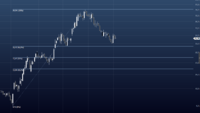You are using an out of date browser. It may not display this or other websites correctly.
You should upgrade or use an alternative browser.
You should upgrade or use an alternative browser.
Specific value on Log Scale
- Thread starter mombandre
- Start date
Dr.Peterson
Elite Member
- Joined
- Nov 12, 2017
- Messages
- 16,865
I know nothing about the context, but on a semilog graph, the labels are the values; the value of 21.42 is 21.42. You don't need to know the logarithm of that, as far as I can tell without knowing why you ask.
The percentages appear to refer to the logs, not the actual values. It's 61.8% of the way from bottom to top as actually measured on the graph.
Can you tell us more about what you want to do with the answer?
The percentages appear to refer to the logs, not the actual values. It's 61.8% of the way from bottom to top as actually measured on the graph.
Can you tell us more about what you want to do with the answer?
This is a totally absurd presentation due to its lack of specifics.
If, however, that faint line is supposed to be a line of best fit, it is dubious because the residuals for small x are uniformly positive and the resuduals for large x are uniformly negative.
I had a friendly argument with SK about this recently. You can always find a line of best fit for any hypothesized type of functional relationship. It does not mean the the best fit is any good. Non-random residuals are an indicator that the line of best fit is actually a bad fit.
If, however, that faint line is supposed to be a line of best fit, it is dubious because the residuals for small x are uniformly positive and the resuduals for large x are uniformly negative.
I had a friendly argument with SK about this recently. You can always find a line of best fit for any hypothesized type of functional relationship. It does not mean the the best fit is any good. Non-random residuals are an indicator that the line of best fit is actually a bad fit.
Dr.Peterson
Elite Member
- Joined
- Nov 12, 2017
- Messages
- 16,865
Looking back at this question, I realize I misinterpreted it. I apologize; your English is not as bad as I must have supposed it to be.Hi guys. I'm new here.
I'm stucked in a very simple question:
How I'm supossed to find out the value 21,42? This value corresponds to 61,8% of the range from 9,17 to 34,94.
This is a logscale (and I actually dont know its basis).
I think you were asking how to obtain the value 21.42 given the values 9.71 and 34.94, and the percentage 61.8%.
To generalize, suppose the lower and upper values are A and B. Then the actual positions on the graph are log(A) and log(B). Given a percentage P, we want that percentage of the range log(B)-log(A) = log(B/A), added to log(A): that is, the log of the desired position is log(A) + P log(B/A) = log(A*(B/A)^P). Therefore, the value at that percentage on the graph is the antilog of this, C = A*(B/A)^P.
In the example, A = 9.17, B = 34.94, and P = 0.618. Therefore, C = A*(B/A)^P = 9.17*(34.94/9.17)^0.618 = 9.17*(3.81)^0.618 =9.17*2.2858 = 20.96.
Possibly the numbers in the image are rounded slightly. Or else I've made a mistake somewhere.
But my question is, how did they choose the value 61.8%? Is it meant to be the golden ratio, or something else? And is it supposed to be significant?
Cubist
Senior Member
- Joined
- Oct 29, 2019
- Messages
- 1,699
In the example, A = 9.17, B = 34.94, and P = 0.618. Therefore, C = A*(B/A)^P = 9.17*(34.94/9.17)^0.618 = 9.17*(3.81)^0.618 =9.17*2.2858 = 20.96.
Possibly the numbers in the image are rounded slightly.
The OP misquoted 9.17 instead of the 9.71 shown in the graph. Using the latter your calculation gives the expected result...
A = 9.71, B = 34.94, and P = 0.618. Therefore, C = A*(B/A)^P = 9.71*(34.94/9.71)^0.618 ≈.21.424

